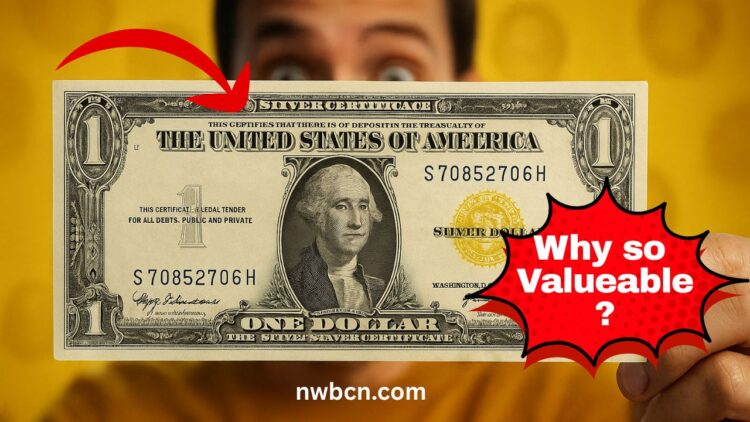During World War II, the U.S. issued special currency for overseas troops and occupied regions. Among these was the 1935A $1 Silver Certificate, printed with a distinctive yellow treasury seal instead of the standard blue.
Known as the “North Africa Emergency Note,” it was created in 1942 for use in Operation Torch. Its unique seal was designed for easy identification and rapid demonetization in case of capture by enemy forces.
Today, these notes are highly prized by collectors due to their historical context, rarity, and distinctive design.
Why the Yellow Seal Was Necessary
- Emergency measure during Operation Torch: U.S. and Allied soldiers in North Africa needed recognizable currency that could be invalidated if seized.
- Instant recognition: The bright yellow seal ensured immediate visual distinction from regular notes. In the event of defeat, the Treasury could demonetize captured currency quickly .
- Issuance and reuse: First printed in 1942, the design was also used during the 1943 invasion of Sicily.
Design & Features
These notes share much of the design with standard silver certificates, including:
- Obverse: Portrait of George Washington and signature block.
- Reverse: The Great Seal of the United States and iconic “All-Seeing Eye.”
- Treasury Seal: Bright yellow instead of blue, making it the only small-size U.S. note with such a seal.
Rarity and Estimated Numbers
| Attribute | Details |
|---|---|
| Series | 1935A North Africa (emergency issue) |
| Denomination | $1 Silver Certificate |
| Seal Color | Yellow |
| Estimated Survivors | Few thousand—most redeemed or discarded post-war |
| Denominations printed | Also issued in $5 and $10 notes |
| Usage period | 1942–1943 in North Africa and Sicily |
| Collectors’ demand | High; distinctive war-time emergency series |
Value & Market Rates
Collector demand varied by condition, grading, and provenance:
- Very Fine (VF): $125–$200
- Extra Fine (EF): $184–$340
- About Uncirculated (AU): $340–$595+
- Uncirculated (MS/UNC): $595–$1,000+
Star note and special serial examples can command premiums, often exceeding $1,500 to $2,000.
Why Collectors Love It
- Wartime context – A tangible piece of WWII currency tied to key campaigns.
- Unique design – Only yellow-sealed small-size Silver Certificate.
- Limited circulation – Redeemed or destroyed post-war, making survivors scarce.
- Historical intrigue – Symbolizes military strategy and economic planning.
1935A North Africa Silver Certificate Condition vs. Value
| Condition Grade | Color Seal | Market Value Range |
|---|---|---|
| Very Fine (VF) | Yellow | $125–$200 |
| Extra Fine (EF) | Yellow | $184–$340 |
| About Uncirculated | Yellow | $340–$595 |
| Uncirculated (UNC) | Yellow | $595–$1,000+ |
| Star Note | Yellow | $1,500–$2,500+ (graded) |
Collecting Tips
- Seal confirmation: Ensure seal is indeed yellow, not faded blue.
- Condition assessment: Look for minimal wear, margins, and bright print.
- Certification: Grading by PMG or PCGS Currency enhances value.
- Check serials: Star notes and unique serials may attract higher prices.
Legal Tender Status
- These notes remained legal tender for face value during and after the war.
- Despite possible demonetization in hostile territory, they remained valid in the U.S.
- Today they can be redeemed in person or with treasure, but most are sold to collectors due to historical value.
Historical Spread: Other Emergency Notes
- Hawaii Overprint Notes (1934–1944): Brown seal + “HAWAII” overlay for use after Pearl Harbor
- North Africa Series: Yellow-seal $1, $5, $10 notes printed 1942–43
- Both series share the aim of allowing easy demonetization and tracking of regional currency.
The 1935A North Africa $1 Silver Certificate with yellow seal is more than just paper money—it’s a military artifact, an economic instrument, and a collector’s jewel.
Issued during a pivotal global conflict, quickly replaced after the war, and surviving in limited numbers, it remains a sought-after piece of history.
Graded and well-preserved examples can achieve strong prices, with high-grade or star-noted specimens valued in the high hundreds or beyond.
FAQs
Q1: Can the yellow seal fade to blue over time?
No. The yellow seal pigment is distinct; a faded yellow may appear lighter but never turns blue.
Q2: Are these notes still legal tender today?
Yes. They remain valid for face value, though most are redeemed by collectors.
Q3: How can I verify authenticity?
Have the note graded by PMG or PCGS Currency. Authentic North Africa notes will feature the yellow seal and wartime signatures (Julian–Morgenthau).
